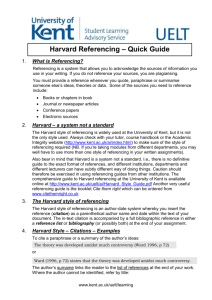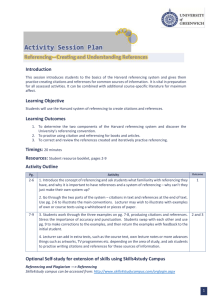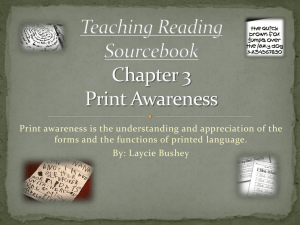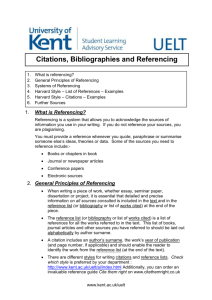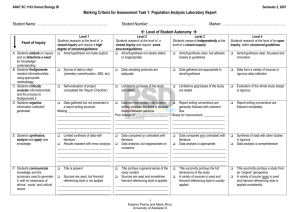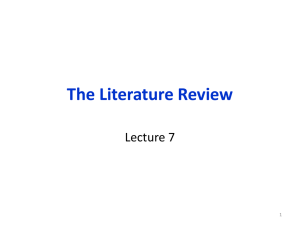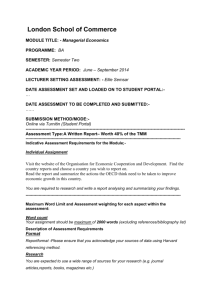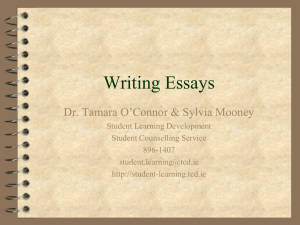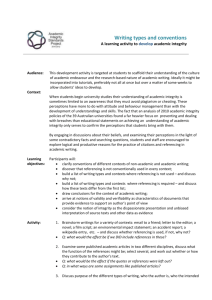Discussion /Analysis /Critical evaluation &/or Reflection
advertisement
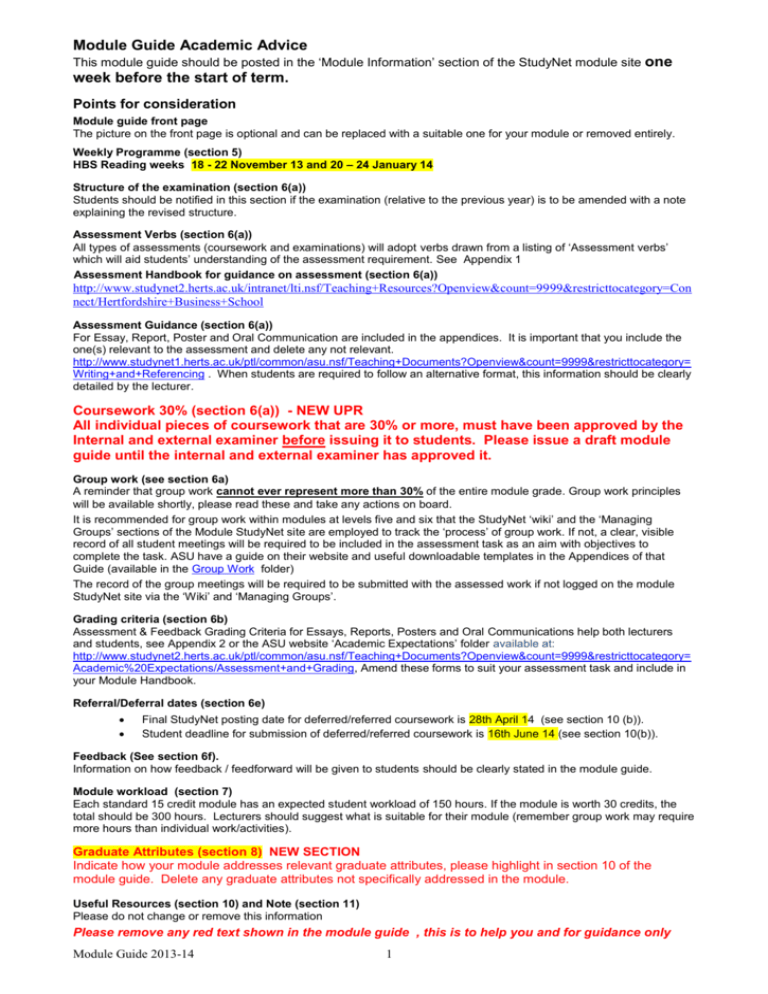
Module Guide Academic Advice This module guide should be posted in the ‘Module Information’ section of the StudyNet module site one week before the start of term. Points for consideration Module guide front page The picture on the front page is optional and can be replaced with a suitable one for your module or removed entirely. Weekly Programme (section 5) HBS Reading weeks 18 - 22 November 13 and 20 – 24 January 14 Structure of the examination (section 6(a)) Students should be notified in this section if the examination (relative to the previous year) is to be amended with a note explaining the revised structure. Assessment Verbs (section 6(a)) All types of assessments (coursework and examinations) will adopt verbs drawn from a listing of ‘Assessment verbs’ which will aid students’ understanding of the assessment requirement. See Appendix 1 Assessment Handbook for guidance on assessment (section 6(a)) http://www.studynet2.herts.ac.uk/intranet/lti.nsf/Teaching+Resources?Openview&count=9999&restricttocategory=Con nect/Hertfordshire+Business+School Assessment Guidance (section 6(a)) For Essay, Report, Poster and Oral Communication are included in the appendices. It is important that you include the one(s) relevant to the assessment and delete any not relevant. http://www.studynet1.herts.ac.uk/ptl/common/asu.nsf/Teaching+Documents?Openview&count=9999&restricttocategory= Writing+and+Referencing . When students are required to follow an alternative format, this information should be clearly detailed by the lecturer. Coursework 30% (section 6(a)) - NEW UPR All individual pieces of coursework that are 30% or more, must have been approved by the Internal and external examiner before issuing it to students. Please issue a draft module guide until the internal and external examiner has approved it. Group work (see section 6a) A reminder that group work cannot ever represent more than 30% of the entire module grade. Group work principles will be available shortly, please read these and take any actions on board. It is recommended for group work within modules at levels five and six that the StudyNet ‘wiki’ and the ‘Managing Groups’ sections of the Module StudyNet site are employed to track the ‘process’ of group work. If not, a clear, visible record of all student meetings will be required to be included in the assessment task as an aim with objectives to complete the task. ASU have a guide on their website and useful downloadable templates in the Appendices of that Guide (available in the Group Work folder) The record of the group meetings will be required to be submitted with the assessed work if not logged on the module StudyNet site via the ‘Wiki’ and ‘Managing Groups’. Grading criteria (section 6b) Assessment & Feedback Grading Criteria for Essays, Reports, Posters and Oral Communications help both lecturers and students, see Appendix 2 or the ASU website ‘Academic Expectations’ folder available at: http://www.studynet2.herts.ac.uk/ptl/common/asu.nsf/Teaching+Documents?Openview&count=9999&restricttocategory= Academic%20Expectations/Assessment+and+Grading, Amend these forms to suit your assessment task and include in your Module Handbook. Referral/Deferral dates (section 6e) Final StudyNet posting date for deferred/referred coursework is 28th April 14 (see section 10 (b)). Student deadline for submission of deferred/referred coursework is 16th June 14 (see section 10(b)). Feedback (See section 6f). Information on how feedback / feedforward will be given to students should be clearly stated in the module guide. Module workload (section 7) Each standard 15 credit module has an expected student workload of 150 hours. If the module is worth 30 credits, the total should be 300 hours. Lecturers should suggest what is suitable for their module (remember group work may require more hours than individual work/activities). Graduate Attributes (section 8) NEW SECTION Indicate how your module addresses relevant graduate attributes, please highlight in section 10 of the module guide. Delete any graduate attributes not specifically addressed in the module. Useful Resources (section 10) and Note (section 11) Please do not change or remove this information Please remove any red text shown in the module guide , this is to help you and for guidance only Module Guide 2013-14 1 Module Guide 2013-14 Module Title - Module Code - Academic Year - 2012/13 Semester Module Leader – Module Guide 2013-14 2 Contents: 1 Contact details for the module leaders (and teaching team) Name 2a Room Phone extension E mail address Office & Feedback hours Module aims See DMD section 10 to ‘cut and paste’ 2b Learning Outcomes See DMD section 11(a) and 11(b) to ‘cut and paste’ Knowledge and Understanding Successful students will typically: Skills and Attributes Successful students will typically: 3 Format of delivery e.g. One hour lecture and one hour tutorial each week 4 How StudyNet will be used to support this module Describe how the StudyNet site for this module will be employed on your module. For example, FAQs, Reading list, Discussion Board, Assignment details and submission, Wiki information for group work. 5a Weekly programme to include: Week / Date Theme / Topics to be covered Session content: Indication of likely activities in lecture / tutorial /seminar / workshop Assessment: hand-out date if known, submission date, return date (within 4 weeks of submission) Seminars/Tutorial preparation required Weekly readings with instructions, e.g. read x before the lecture/ to prepare for... Any other relevant information E.g. Semester A – Module Title Week/Date: Theme /Topic 1/27 September Orientation Session content: Student tasks: Reading: Lecture: 20 minutes max. Highlight key university features such as dropin hours, SSG, hand-in procedures, and important locations. Guided or self-guided tours including ‘treasure hunt’ element with second years leading. Students complete spreadsheet to hand-in in class. Self-study task is to access spreadsheet and complete electronically for next session. tba Seminar: Demonstrate accessing StudyNet, module and programme Module Guide 2013-14 3 Task: Students homepages, module handbooks/coursework deadlines. complete a 7-day pre-printed spreadsheet of all their commitments. nb All aspects of the module are potentially examinable. The information given in this Module Guide is believed correct, but HBS reserves the right, at its discretion, and for any reason, to make changes to the Guide, syllabus and/or module without prior notice. 5b Reading List and Key Text Check Voyager for reading list items and notify your Information Manager (Mike Mylles or Jane Bilson) if copies are required. If an appropriate electronic book is available, please refer students to this as the core text. If more than one core text book is suggested, please indicate to students they only need to buy one of the recommended books. If you want to embed links to learning resources in your StudyNet pages, please see the guidance developed by Jane Bilson and Mike Mylles by clicking on the link below. http://www.studynet2.herts.ac.uk/intranet/lti.nsf/Teaching+Documents?Openview&count=9999& restricttocategory=Connect/Hertfordshire+Business+School Make sure you use HBS Harvard Referencing, as detailed on ASU website, setting an example to students e.g. Hillier, F. S. & Lieberman, G.J. (2005) Introduction to Operations Research. 9th edn. London: McGraw Hill. 6a Assessment details to include: Examination / Coursework weighting: See DMD section 14(a) and 14(b) to ‘cut and paste’ If students must pass both elements state - ‘To be awarded a pass mark for this module, both examination and coursework must be passed’. Examination details: o time / format Coursework details: o o o o o include word limits/ presentation duration and percentage of the overall module grade hand out date (if known) submission date return date (within four weeks of submission) marking criteria nb Students obtaining less than 20% for the module overall, will not normally be eligible for a referral. 6b The grading criteria ASU have generic grading criteria for essays, reports, posters, presentations, etc. These are designed to be adopted and then adapted for your specific needs. Please, amend the details/marks to suit your assessment. If you are using your own criteria, state it clearly. See Appendix 2. These grading criteria will also be available on StudyNet from September 14. http://www.studynet2.herts.ac.uk/ptl/common/asu.nsf/Teaching+Documents?Openview&count=9 999&restricttocategory=Academic%20Expectations/Assessment+and+Grading HBS grading criteria for student coursework on this module are provided in the Appendix. More detail on the specific criteria for each assignment will be provided by the module leader in the assessment workshop incorporated into the teaching days and in information circulated via StudyNet Module Guide 2013-14 4 6c Referencing properly and the risk of plagiarism / academic misconduct Please note that HBS reserves the right to use electronic means to identify plagiarism. Students are advised to ensure that they know how to reference using Harvard Referencing System, and that all material used in their coursework is correctly referenced to indicate the source. The Academic Skills Unit has plenty of resources to assist students in academic writing and can be accessed via StudyNet. HBS reserves the right to viva students as a method to test that work produced is the students’ own work. 6d How the assessment relates to the Module Learning Outcomes See DMD section 11(a) and 11(b) to ‘cut and paste’– exam and coursework, tick() as appropriate. Add / delete rows and columns for required number of learning outcomes and pieces of courswork assessment. Learning Outcomes Knowledge and understanding CW1 CW2 Exam Skills and Attributes Key: CW – Coursework 6e Deferral/Referral Assessment Refer/Defer assessment details are not required within the Module Guide. However, if there are any changes in the format of the assessment, they must be provided in the module guide. However, all referred/deferred coursework must be written at the same time as the original coursework and if necessary sent to the external examiner. Specific details of the referred/deferred coursework will be put on StudyNet by 28 April 2014, and the submission date for that work is for all referred/deferred coursework assessments will be 16 June 2014. This deadline relates to semester A, semester B and semester A/B referred/deferred coursework. 6f Feedback on your module Feedback from assessed coursework assignments will normally be provided either using the ‘StudyNet Online Feedback Form’ or by the HBS ‘Assessment Feedback Form' which will provide feedback/feedforward on many aspects of your work and on how you can improve in future assignments. Formative and/or general feedback may also be given in class time. Please add any further information on how you will give feedback to the students for this module 7 Likely Module Workload Activities Total Lectures Seminars / Tutorials / Workshop Module Guide 2013-14 12 12 5 Hours per week 1 1 Assignment 1 (e.g. 40 hours) - Research, writing, drafting and editing E.g. Complete as appropriate Pre-lecture/ reading Seminar preparation, e.g. for weekly tasks Exam Preparation other Total 8 40 96 150 hours per 15 credits On average 10 hours per week per module Graduate Attributes Please indicate briefly how your module addresses relevant graduate attributes. Delete any graduate attributes not addressed in the module. Professionalism, employability and enterprise The University promotes professional integrity and provides opportunities to develop the skills of communication, independent and team working, problem solving, creativity, digital literacy, numeracy and self-management. Our graduates will be confident, act with integrity, set themselves high standards and have skills that are essential to their future lives. Learning and research skills The University fosters intellectual curiosity and provides opportunities to develop effective learning and research abilities. Our graduates will be equipped to seek knowledge and to continue learning throughout their lives. Intellectual depth, breadth and adaptability The University encourages engagement in curricular, co-curricular and extracurricular activities that deepen and broaden knowledge and develop powers of analysis, application, synthesis, evaluation and criticality. Our graduates will be able to consider multiple perspectives as they apply intellectual rigour and innovative thinking to the practical and theoretical challenges they face. Respect for others The University promotes self-awareness, empathy, cultural awareness and mutual respect. Our graduates will have respect for themselves and others and will be courteous, inclusive and able to work in a wide range of cultural settings. Social responsibility The University promotes the values of ethical behaviour, sustainability and personal contribution. Our graduates will understand how their actions can enhance the wellbeing of others and will be equipped to make a valuable contribution to society. 9 Useful resources for support with your modules o o o Academic Skills Unit (ASU) http://www.studynet.herts.ac.uk/go/asu Information Hertfordshire Information Hertfordshire Toolkit for Business and may help you choose the best sources for different types of business information and include Online tutorials and quizzes . Academic Integrity http://www.studynet2.herts.ac.uk/ptl/common/asu.nsf/Teaching+Documents?Openview&c ount=9999&restricttocategory=Academic+Expectations/Academic+Integrity Module Guide 2013-14 6 10 Serious Adverse Circumstances 'Serious adverse circumstances' are significant circumstances beyond a student’s control that would have affected the student’s ability to perform to their full potential if they were to submit or attend assessments at the appointed time. If, despite such circumstances, you decide to sit/submit an assessment, the University will not normally accept a claim of serious adverse circumstances in respect of that assessment. If there are Serious Adverse Circumstances that have affected your assessment(s), you must communicate details to the University together with appropriate evidence, using the form provided by your School. Please read the University’s guidance on Serious Adverse Circumstances before you sit/submit an assessment. Full guidance can be found in your Programme Handbook and in the ‘A - Z Guide’ for students on StudyNet 11 Module deadline extensions Only module leaders have the discretion to grant individual extensions to coursework deadlines for their module. Appropriate evidence will need to be provided to them ahead of the original deadline, and students should ensure that they make an appointment to discuss their extension request with their Module Leader. Karen Robins Associate Dean of School Learning and Teaching July 2013 Module Guide 2013-14 7 Appendix 1 Hertfordshire Business School Assessment Verbs for Exams and Assignments Term Meaning KNOWLEDGE Classify Define Describe Identify List Record State Summarise Arrange into groups/divide according to class/type Explain precisely; state the meaning of; give details to show boundaries/distinguish it from others State a detailed account; information showing what/why/when/where/how/who something/ one is Name, specify, point out, pick out key facts, features, criteria, etc Catalogue; name items in a sequence; mention briefly Register data, make accurate note of facts, evidence Express main points carefully, completely, briefly and clearly; specify Give an account/overview of the topic /main points of; make a short general statement about COMPREHENSION Calculate Work out/find out using your judgement; determine; weigh reasons carefully Compare Examine two or more things / ideas in order to focus on their relationship/likeness/similarities & only mention/acknowledge differences Discuss Consider from several points of view & explore implications; put the case for and against a proposition & end with some statement of your own position Explain Make clear and understandable; give reasons for; interpret and account for Express Clearly state, show an opinion/a fact/a feeling Indicate Show; point out; draw attention to; give evidence of; make clear; Prepare Present Quantify Recognise Relate Report Review Translate Get ready, set up, practise and/or make something, e.g. a presentation To introduce & deliver/depict/portray/display/demonstrate/show, put forward arguments for and expound a case, to being to notice Express/measure the amount or quantity of Identify, recall, recollect, acknowledge, spot, notice, endorse, accept as valid, appreciate, pick out Show/establish how things are linked to & impact upon each other, and to what extent they are alike Give an account of, inform, recount, relate, record Make a survey of, examining the subject critically; consider and judge carefully Interpret, convert, decode and explain APPLICATION Apply Explain something, e.g. theory, with links, evidence and examples, e.g. from the real business world so shows something is understood Demonstrate Show clearly by giving evidence/proof/examples. Develop the idea by reasoning and example Derive Obtain results/draw from/ develop Find Discover something, e.g. information, reveal meaning, locate, obtain Forecast Predict, estimate or calculate possible results linked to criteria, complete or incomplete facts or reasoning Highlight Emphasise, stress, underline, show up, focus, attention on, give prominence to Illustrate Make clear by using examples; use figures or diagrams to explain; show the meaning of something by giving related examples Implement Put into practice or action a plan, apply, employ, instigate Plan Arrange something or event; with aims, times, stages, sequence, outcomes Produce Make, create, construct something or make clear case for Reconcile Bring together, settle/resolve issues, e.g. levels of acceptance of a statement/proposition Schedule Plan and identify the order of actions or events within a set timescale, agenda, calendar, rota, list Solve Unravel the issues, work out the answer, decipher and explain Tabulate Put things in a table or chart to show clear results/information Use Employ, apply something, apply and draw on experience, knowledge Validate Confirm, authenticate, certify, endorse, support with evidence Verify Make sure that something is accurate/true; check; prove that with evidence… Approved by FLTG, 28/1/09. Updated 10/06/12 8 © HBS, 2009. ANALYSIS Analyse ‘Take apart’ an idea or statement; ‘unpack’; deconstruct; examine in depth & consider how the parts interrelate, give reasons & answers to questions (e.g. Who? What? Where? When? Which? Why? How?) Argue Make a case based on appropriate evidence to support a point of view Compare & Compare two or more objects/things/people to focus on their similarities and their differences contrast Debate Question/dispute/deliberate/argue a view or case Differentiate Explain/show how something is different from something else Distinguish Identify the differences between/separate/discriminate Examine Consider; look closely at a question to find out Interpret Give an account of the meaning; use your judgement indicating relationships to others or way of looking at Propose To offer or put forward for consideration or acceptance, something to be undertaken Question Query subject matter; make enquiries to identify and address issues/problems, to consider and doubt facts and possibilities, complete and incomplete knowledge/understanding Test Question and check out material/views; investigate and experiment to assess evidence, try to prove SYNTHESIS Create Generate/construct/design/invent some original thought/idea/thing/product Design Devise/plan/invent/draw up plans/propose/formulate Determine Find out something exactly; establish/decide Explore Discover more about; look carefully for; investigate; seek for/after; attain by search Formulate Express/compose/devise something by means of a formula or model or specific words/definitions Integrate Incorporate, put together things; combining ideas, theories and /or practices Justify Argue/defend/support an issue or case; provide explanations and reasons/facts/information/ strong evidence and examples Organise Put in some order, sort out people, plans, facts, issues; arrange/systemise Structure Organise and arrange ideas/things in a clearly formulated way; construct obvious shape, by a plan with organisation/ composition Synthesise Consider different materials/views to bring common points together EVALUATION Advise Give suggestions based on your judgement/views about future actions, with explanations /evidence/ reasons Appraise/ Judge the importance/value/ quality/worth of something and give reasons Assess Conclude Give an answer/ summary, a final account, reach a decision about something showing the key steps/points/ reasons/judgements that assisted you in reaching your view/answer Critically…/ Comment on the merit of data/theories/opinions/relevance; judge evidence; weigh up strengths / benefits and faults/weaknesses Critique Estimate Evaluate Judge Recommend Reflect Predict; form an opinion as to the degree/nature/ value/size/amount of Make an appraisal as to the worth of; judge effectiveness/value/quality/nature/use of/amount of State opinion/view based on evidence/examples; ascertain to what distance/amount; to what extent; to what degree Suggest possible actions/routes/outcomes; linked to and based on previously shown knowledge and understanding, may include your views and advise Consider and assess strengths & weaknesses/usefulness/quality/ performance and draw conclusions Approved by FLTG, 28/1/09. Updated 10/06/12 9 © HBS, 2009. UG Standard Assessment & Grading Criteria for HBS Coursework (Report) Module Code:_______________________________ REPORT Presentation & structure Task details Follows report structure & keeps to word limit of ... /marks 80-100 Outstanding 70-79 Excellent 60-69 Very Good 50-59 Good 40-49 Satisfactory 30-39 Marginal Fail 20 – 29 Clear Fail 1 – 19 Little or Nothing of merit Lecturer:________________________________ Use & presentation of Harvard Referencing Follows Harvard style for in-text citation & Reference List Use a minimum of ... sources /e.g. 10 Marks /e.g. 5 Marks Content/ Terms/ Findings/ Definitions/ Calculations Content included - specify task requirements as in module guide & coursework guidance / e.g. 30 Marks Penalty: Student: ________________________________________ Business Application & Integration of Data/Literature Integration & application of information - from coursework guidance /module guide Discussion /Analysis /Critical evaluation &/or Reflection Line of argument, development of discussion add instructional verbs to suit the task & level /e.g. 15 Marks /e.g. 40 Marks Outstanding... Presentation & report structure, with numbered paragraphs, list of contents/figures &appendices. Articulate & fluent academic writing style with ideas cross referenced. No grammatical / spelling errors. Excellent ... Presentation & report structure, with numbered paragraphs, list of contents/figures, appendices & cross referencing. Articulate & fluent academic writing style. Only a minor error. Very good... Presentation & report structure, paragraphing, use of numbering, list of contents/figures, appendices & cross referencing. Fluent academic writing style. Very few grammatical errors & spelling mistakes. Good... Clear presentation & report structure, use of numbering & appendices. Writing is mainly clear but some spelling &/ or grammatical errors. Satisfactory... Basic report structure. Not always written clearly & has grammatical & / or spelling errors. Outstanding... Standard of referencing within text & consistent use of Harvard referencing system. Accuracy of in-text references & full details shown in Reference list. Outstanding... Exploration of topic showing excellent knowledge & understanding through thorough & appropriate research. Impressive choice and range of appropriate content. Outstanding... Business insight & application. Breadth, depth & integration of literature/data into work. Outstanding... Level of discussion/analysis/ critical evaluation &/or reflection. Highly developed/ focused work. Excellent... Standard of referencing within text & consistent use of Harvard referencing system. Accuracy of in-text references & full details shown in Reference list. Excellent ... Level of knowledge & understanding demonstrated. Evidence of appropriate reading. Covers all relevant points & issues. Excellent ... Business insight & application. Breadth, depth & integration of literature/data into work. Excellent... Level of discussion/analysis/ critical evaluation &/or reflection clearly developing points in the appropriate way with thorough consideration of all possibilities. Very good... Standard of referencing within text & consistent use of Harvard referencing system. Accuracy of in-text references & full details shown in Reference list. Very good... Level of knowledge & understanding demonstrated. Covers most relevant points & issues. Few errors / omissions in content/calculations. Very good... Business insight & application. Breadth, depth & integration of literature/data into work. Very good... Level of discussion/analysis/ critical evaluation &/or reflection & a few ideas/points could benefit from further development &/or evaluation/comparison. Good... Standard of referencing within text & consistent use of Harvard referencing system. Accuracy of in-text references & full details shown in Reference list. Good... Grasp of the topic & some of its implications presented. Knowledge & understanding is demonstrated. Minor errors / omissions in content/ calculations. Satisfactory... Content / level of knowledge of the topic. Addresses part of the task. Some errors / omissions in content/ calculations. May benefit from further research. Good... Business insight & application. Breadth, depth & integration of literature/data into work. Good... Level of discussion/analysis/ critical evaluation &/or reflection but more ideas/points could be addressed /developed further. Satisfactory... Business insight & application. Limited integration with literature/ data. Use of literature/data but limited in breadth OR depth. Satisfactory... Basic evidence of discussion/analysis/ critical evaluation &/or reflection but some points superficially made so need further development. Weak... Report format, limited or poor structure. Muddled work with many spelling & / or grammatical errors. Weak...Use of Harvard referencing system with errors & inconsistently applied. Limited referencing within the text. Limited accuracy of in-text references compared to those in the final Reference list. Inadequate... Use of Harvard referencing with many errors &/or inconsistencies. Weak... Limited content / knowledge/ calculations. Limited or muddled understanding of the topic/question. Does not meet all the learning outcomes. Inadequate... Lacking in relevant content/ knowledge/calculations. Content irrelevant / inaccurate. Does not meet all the learning outcomes. Weak... Unsatisfactory evidence of business application & insight Work needs to show better links between practical application and theory. Weak... Limited evidence of discussion/analysis/ critical evaluation &/or reflection. More development & comment needed. May need to do more than describe. Inadequate... Lacking / inadequate level of discussion/ analysis/critical evaluation & /or reflection. Descriptive. Must see ASU Nothing of merit... Unsatisfactory level of knowledge demonstrated. Content used irrelevant / not appropriate/ to the topic. Does not meet the learning outcomes. Nothing of merit... No evidence of appropriate business application & insight. Inadequate... Report format and poor paragraphing / signposting. Inappropriate writing style Poorly written &/or poor spelling & grammar. Must see ASU Nothing of merit... Poorly written work, lacking structure, paragraphing / signposting. Many inaccuracies in spelling & grammar. Must see ASU Satisfactory... Basic referencing within text & consistent use of Harvard referencing system. Accuracy of in-text references & full details shown in Reference list. Must see ASU Nothing of merit... No or little attempt to use the recommended Harvard referencing system. Must see ASU This form is used by staff & students to provide feedback to assist students’ future work. Approved by FLTG, 28/1/09. Updated 10/06/12 10 © HBS, 2009. Inadequate... Lacks evidence of business application & insight. Some literature irrelevant to topic. Nothing of merit... Unsatisfactory level of discussion/analysis/critical evaluation &/or reflection Must see ASU Total Mark Awarded: Any other lecturer instructions Lecturer comments: UG Standard Assessment & Grading Criteria for HBS Coursework (Essay) Module Code:_______________________________ ESSAY Presentation & structure Task details Follows essay structure & keeps to word limit of ... /marks 80-100 Outstanding 70-79 Excellent 60-69 Very Good 50-59 Good 40-49 Satisfactory 30-39 Marginal Fail 20 – 29 Clear Fail 1 – 19 Little or Nothing of merit Lecturer:________________________________ Use & presentation of Harvard Referencing Follows Harvard style for in-text citation & Reference List Use a minimum of ... sources /e.g. 10 Marks /e.g. 5 Marks Content/ Terms/ Findings/ Definitions/ Calculations Content included - specify task requirements as in module guide & coursework guidance / e.g. 30 Marks Penalty: Student: ________________________________________ Breadth / Depth / Integration of Literature Integration & application of information - from coursework guidance /module guide Analysis /Critical evaluation /Discussion /Exposition/Reflection Line of argument, development of discussion add instructional verbs to suit the task & level /e.g. 15 Marks /e.g. 40 Marks Outstanding... Presentation & essay structure, with flowing paragraphs. Articulate & fluent academic writing style No grammatical / spelling errors. Outstanding... Standard of referencing within text & consistent use of Harvard referencing system. Accuracy of in-text references & full details shown in Reference list. Outstanding... Exploration of topic showing excellent knowledge & understanding through thorough & appropriate research. Impressive choice and range of appropriate content. Outstanding... Business insight & application. Breadth, depth & integration of literature/data into work. Outstanding... Level of discussion/analysis/ critical evaluation &/or reflection. Highly developed/ focused work. Excellent ... Presentation & essay structure, with flowing paragraphs. Articulate & fluent academic writing style. Only a minor error. Very good... Presentation & essay structure, with flowing paragraphs. Fluent academic writing style. Very few grammatical errors & spelling mistakes. Good... Clear presentation & essay structure with paragraphing. Writing is mainly clear but some spelling &/ or grammatical errors. Satisfactory... Basic essay structure. Not always written clearly & has grammatical & / or spelling errors. Excellent... Standard of referencing within text & consistent use of Harvard referencing system. Accuracy of in-text references & full details shown in Reference list. Excellent ... Level of knowledge & understanding demonstrated. Evidence of appropriate reading. Covers all relevant points & issues. Excellent ... Business insight & application. Breadth, depth & integration of literature/data into work. Very good... Standard of referencing within text & consistent use of Harvard referencing system. Accuracy of in-text references & full details shown in Reference list. Very good... Level of knowledge & understanding demonstrated. Covers most relevant points & issues. Few errors / omissions in content/calculations. Good... Grasp of the topic & some of its implications presented. Knowledge & understanding is demonstrated. Minor errors / omissions in content/ calculations. Satisfactory... Content / level of knowledge of the topic. Addresses part of the task. Some errors / omissions in content/ calculations. May benefit from further research. Very good... Business insight & application. Breadth, depth & integration of literature/data into work. Good... Business insight & application. Breadth, depth & integration of literature/data into work. Excellent... Level of discussion/analysis/ critical evaluation &/or reflection clearly developing points in the appropriate way with thorough consideration of all possibilities. Very good... Level of discussion/analysis/ critical evaluation &/or reflection & a few ideas/points could benefit from further development &/or evaluation/comparison. Good... Level of discussion/analysis/ critical evaluation &/or reflection but more ideas/points could be addressed /developed further. Satisfactory... Business insight & application. Limited integration with literature/ data. Use of literature/data but limited in breadth OR depth. Satisfactory... Basic evidence of discussion/analysis/ critical evaluation &/or reflection but some points superficially made so need further development. Weak... Essay format, limited or poor structure. Muddled work with many spelling & / or grammatical errors. Weak...Use of Harvard referencing system with errors & inconsistently applied. Limited referencing within the text. Limited accuracy of in-text references compared to those in the final Reference list. Inadequate... Use of Harvard referencing with many errors &/or inconsistencies. Weak... Limited content / knowledge/ calculations. Limited or muddled understanding of the topic/question. Does not meet all the learning outcomes. Inadequate... Lacking in relevant content/ knowledge/calculations. Content irrelevant / inaccurate. Does not meet all the learning outcomes. Weak... Unsatisfactory evidence of business application & insight Work needs to show better links between practical application & theory. Weak... Limited evidence of discussion/analysis/ critical evaluation &/or reflection. More development & comment needed. May need to do more than describe. Inadequate... Lacking / inadequate level of discussion/ analysis/critical evaluation & /or reflection. Descriptive. Must see ASU Nothing of merit... Unsatisfactory level of knowledge demonstrated. Content used irrelevant / not appropriate/ to the topic. Does not meet the learning outcomes. Nothing of merit... No evidence of appropriate business application & insight. Inadequate... Essay format & poor paragraphing / signposting. Inappropriate writing style Poorly written &/or poor spelling & grammar. Must see ASU Nothing of merit... Poorly written work, lacking structure, paragraphing / signposting. Many inaccuracies in spelling & grammar. Must see ASU Good... Standard of referencing within text & consistent use of Harvard referencing system. Accuracy of in-text references & full details shown in Reference list. Satisfactory... Basic referencing within text & consistent use of Harvard referencing system. Accuracy of in-text references & full details shown in Reference list. Must see ASU Nothing of merit... No or little attempt to use the recommended Harvard referencing system. Must see ASU This form is used by staff & students to provide feedback to assist students’ future work. Approved by FLTG, 28/1/09. Updated 10/06/12 11 © HBS, 2009. Inadequate... Lacks evidence of business application & insight. Some literature irrelevant to topic. Nothing of merit... Unsatisfactory level of discussion/analysis/critical evaluation &/or reflection Must see ASU Total Mark Awarded: Any other lecturer instructions Lecturer comments: UG Standard Assessment & Grading Criteria for HBS Coursework: Oral Communication (Presentation, debate, exposition of process /poster) Module Code/ Title: 1. 2. 3. Title/Topic chosen: Presentation Date & Time: Pathway / Level: Name(s) of Group Members (provide family name first): 4. 5. Time allocated to present: 80-100 Outstanding TICK APPROPRIATE GRADE BOX Note: The performance indicators in this grid may not accurately constitute the grade 70-79 Excellent 60-69 Very Good CONTENT OF PRESENTATION (Lecturer to advise task detail & %, e.g. TOTAL 50% - based on the criteria listed below) QUALITY OF CONTENT/ANALYSIS/EVALUATION Focused on the task & addresses it Displays knowledge & understanding: Inclusion of appropriate/relevant theories; accurate/relevant application of data/theory/practice/examples EVIDENCE OF RESEARCH Appropriately used relevant research Harvard referencing system used DELIVERY (Lecturer to advise % allocated to criteria for group/individual, e.g. TOTAL: 50% - based on the criteria listed below) PLANNING/ORGANISATION OF MATERIAL/TOPICS Coherent structure/organisation evident in the process/distribution between speakers LINKAGE/SIGNPOSTING Logical sequence USE OF LANGUAGE Articulate & fluent; language is clear & concise USE OF BODY LANGUAGE Enhances the presentation Appropriate use of gestures/posture/hands/ body movement/facial expressions- eyes, smile Position: in relation to the screen SUPPORT MATERIALS (e.g. PowerPoint slides, poster, etc) Professional/business-like quality; clear images & ‘audience friendly’ i.e. use of colour/font/not overcrowded Interesting & attractive; appropriately used TIMING OF DELIVERY Keeps to allocated time & effective pacing TEAM/INDIVIDUAL WORKING Cohesive/co-ordinated group Business-like style; rehearsed & smooth DELIVERY Interesting Natural & confident /positive attitude Excellent use of memory/recall without over-reliance on reading cue cards Appropriate: volume/speed/eye-contact/animation & humour APPROPRIATE DRESS Business-like AUDIENCE Effective impression; useful/persuasive for/to the audience/client Rapport with the audience - their interest is well maintained Q&A / GROUP VIVA Appropriate/convincing argument/responses to questions asked; confident Everyone ready to join in and make valid points OTHER COMMENTS/OVERALL IMPRESSION Marks for Content Peer Tutor Marks for Presentation Skill Peer Tutor Overall Agreed Mark For Group Work: a Group Log is likely to be used as part of the assessment grade (Available in ‘Participating in Group Work’ Guide: http://www.studynet2.herts.ac.uk/ptl/common/asu.nsf/Teaching+Documents?Openview&count=9999&restricttocategory=Groupwork) Approved by FLTG, 28/1/09. Updated 10/06/12 12 © HBS, 2009. Tutor Signature: Second Signature: 6. Time allocated for Q&A: 50-59 40-49 Good Satisfactory 30-39 Marginal Fail 20 – 29 Clear Fail 1-19 Little or Noth ing of Merit UG Standard Assessment & Grading Criteria for HBS Coursework (POSTER PRESENTATION) Penalty: Module Code:___________________________ Lecturer:________________________________ Student/s: _________________________________________________ POSTER Task details Presentation design & structure Clear poster design, message & structure in line with the brief, word limit of ... /e.g. 20 Marks Use of Harvard Referencing Harvard style in-text citation (& Reference List on reverse) Use a minimum of ... sources /e.g. 5 Marks Content/ Terms/ Findings/ Definitions/ Calculations Content included - specify task requirements as in module guide & coursework guidance / e.g. 30 Marks Business Application & Integration of Data/Literature Integration & application of information – thru a Q&A session or as in module guide /e.g. 20 Marks Discussion /Analysis /Critical evaluation &/or Reflection Line of argument, development of discussion, add instructional verbs/ recommendations to suit the task & level /e.g. 25 Marks /100marks 80-100 Outstanding 70-79 Excellent 60-69 Very Good 50-59 Good 40-49 Satisfactory 30-39 Marginal Fail 20 – 29 Clear Fail 1 – 19 Little or Nothing of merit Outstanding... Innovative, eyecatching effective design. Finished to a professional standard. Easy to follow with creative use of varied graphics, e.g. figures & tables; appropriate colour, legible font, size & style. No grammatical / spelling errors. Excellent ... Innovative, eyecatching effective design. Easy to follow with clear title, message creative use of varied graphics, e.g. figures & tables; appropriate colour, legible font, size & style. No grammatical / spelling errors. Very good... Eye-catching, effective & easy to follow with a clear title, message & use of varied graphics, e.g. figures, tables; appropriate colour, legible font, size & style. A minor grammatical /spelling error. Good... Interesting, neat & clear. Some use of creative design: graphics, e.g. figures, tables; appropriate colour, legible font size & style. Minor grammatical or spelling error. Satisfactory... Use of graphics &/or colour. Limited visual impact/creative design but not always clear. Some grammatical & / or spelling errors. Outstanding... Standard of Harvard referencing within text. Accurate in-text references & full details shown in Reference list, on reverse of poster. Outstanding... Exploration of topic showing excellent knowledge & understanding through thorough & appropriate research. Impressive choice & range of appropriate content. Outstanding... Convincing business insight, application & examples. Individual/group members coordinate & participate effectively – confidently, clearly & respectfully. Outstanding... Level of discussion/analysis/ critical evaluation &/or reflection. Highly developed/ focused work. Excellent... Standard of Harvard referencing within text. Accurate in-text references & full details shown in Reference list, on reverse of poster. Excellent ... Level of knowledge & understanding demonstrated. Evidence of appropriate research. Covers all relevant points & issues. Excellent... Level of discussion/analysis/ critical evaluation &/or reflection clearly developing points in the appropriate way with thorough consideration. Very good... Standard of Harvard referencing within text. Accurate in-text references & details shown in Reference list, on reverse of poster. Very good... Level of knowledge & understanding demonstrated. Covers most relevant points & issues. Few errors / omissions in content/calculations. Excellent ... Convincing business insight, application & examples. Individual/group members coordinate & participate effectively – confidently, clearly & respectfully. Very good... Business insight, application & some examples. Individual/group members coordinate & participate effectively, generally confident, clear & respectful. Good... Standard of Harvard referencing within text. Accurate in-text references & details shown in Reference list, on reverse of poster. Good... Grasp of the topic & some of its implications presented. Knowledge & understanding is demonstrated. Minor errors / omissions in content/ calculations. Satisfactory... Content / level of knowledge of the topic. Addresses part of the task. Some errors / omissions in content/ calculations. May benefit from further research. Good... Level of discussion/analysis/ critical evaluation &/or reflection but more ideas/points could be included. Weak...structure & muddled design with sloppy appearance &/or errors. Lacks visual impact. Weak... Limited referencing within the text, many aspects incorrect or references missing &/or inconsistencies/ lacking references on reverse. Weak... Limited content / knowledge/ calculations. Limited or muddled understanding of the topic/question. Does not meet all of the learning outcomes. Inadequate... inappropriate style Poorly presented – either too cluttered or too limited. Must see ASU Inadequate... limited use of Harvard referencing with many errors &/or inconsistencies. Unethical use of images, without copyright. Must see ASU Nothing of merit... No or little attempt to use Harvard referencing. Unethical use of images, e.g. without copyright. Must see ASU Inadequate... Lacking in relevant content/ knowledge/calculations. Content irrelevant / inaccurate. Meets few of the learning outcomes. Nothing of merit... Unsatisfactory level of knowledge demonstrated. Content used irrelevant / not appropriate/ to the topic. Does not meet the learning outcomes. Good... Business insight, application & some examples. Individual/group members show some effective co-ordination / participation, generally confident, clear & respectful. Satisfactory... Business insight. Limited integration, application &/or examples. Limited coordination, participation &/or confidence, basically clear & usually respectful. Weak... Unsatisfactory evidence of business insight, application & few examples. Individual/group members show insufficient co-ordination & participation or may lack clarity, confidence &/or respect. Inadequate... Lacks evidence of business insight, application &/or co-ordination. Nothing of merit... No evidence of business insight, application or co-ordination. Nothing of merit... Unsatisfactory level of discussion/analysis/critical evaluation &/or reflection Must see ASU Nothing of merit... without visual impact. Inappropriate style. Either too cluttered or too limited. Must see ASU Approved by FLTG, 28/1/09. Updated 10/06/12 Satisfactory... Basic standard of Harvard referencing. A few aspects incorrect or references missing. 13 © HBS, 2009. Very good... Level of discussion/analysis/ critical evaluation &/or reflection & few ideas/points missed. Satisfactory... Basic evidence of discussion/analysis/ critical evaluation &/or reflection but some ideas/points missed. Weak... Limited evidence of discussion/analysis/ critical evaluation &/or reflection. May not fully address the task. Inadequate... Lacking / inadequate level of discussion/ analysis/critical evaluation & /or reflection. Must see ASU Total Mark Awarded: Any other lecturer instructions Lecturer comments: Standard Assessment & Grading Criteria for HBS Coursework Undergraduate Dissertation Undergraduate dissertation grading profile 80-100% Outstanding 1st Class honours Clarity, purpose and achievement of objectives Either: Clear and fully achieved, Or: Clear with critical evaluation explaining failure to achieve. The topic will be current and original. Research and referencing Methodology Critical understanding of relevant theory Analysis of field work, research, topic Structure and coherence Management of dissertation preparation Extensive and up to date research reflected in the text. Wide range of current and relevant references from a variety of sources. Accurate citations using Harvard referencing system. Outstanding and extensive elaboration of relevant concepts, theory or models, all of which are well synthesised and critically evaluated. Either: Clear and fully achieved. Or: Clear with critical evaluation explaining failure to achieve. Extensive and up to date research reflected in the text. Accurate citations using Harvard referencing system. Outstanding and professional presentation. Material is well organised and the dissertation is well structures with clear links between chapters. Clear and lucid writing. Accurate grammar, spelling and punctuation. Excellent presentation and organisation of material. Clear and lucid writing. Accurate grammar, spelling and punctuation. 60%-69% Very good 2(i) Class honours Either: Clear and achieved. Or: Clear with additional explanation for failure to achieve. Good and up to date research reflected in text. Good citation using Harvard referencing system. Clear and achieved to some extent. Adequate research reasonably reflected in text. Satisfactory citations using Harvard referencing system. Methodology understood, explained and justified, alternative methodologies may be considered. Very good presentation and organisation of material. Clear writing. Good standard of grammar, spelling and punctuation. Generally well presented and organised. Clarity of writing satisfactory. Acceptable standard of spelling and punctuation. Deadlines fully met. Evidence of development between different stages of preparation. 50%-59% Good 2(ii) Class honours standard Very good understanding and discussion of relevant concepts, theory or models. Well synthesised. Some evidence of critical evaluation. Good identification of relevant concepts, theory or models. Some attempt to synthesize material. May lack critical evaluation. Rigorous and creative analysis of topic/ field work demonstrating independence of thought. Empirical data and theories are clearly linked to generate pertinent, insightful and thorough conclusions. Rigorous and creative analysis of topic/ field work. Ability to link theory and use empirical data to generate pertinent and insightful conclusions. Very good analysis of data/topic/field-work. Good linkages between theory and empirical data. Sound conclusions showing some reflection. Good attempt to analyse topic/ field work/data. Reasonable linkages between theory and empirical data. Generation of conclusions. Deadlines met or exceeded with evidence of development between stages of preparation. All meetings are proactive as student is very well prepared. 70-79% Excellent 1st Class honours Methodology is very clearly explained, justified and employed. Alternative methodologies given full consideration leaving the reader with no doubt that the chosen method was the most appropriate. Suitable methodology employed, understood, well explained and justified, alternative methodologies considered. Suitable methodology employed, understood explained and justified, alternative methodologies considered. 40%-49% Satisfactory 3rd Class honours standard Not clearly defined or defined but not met and reasons for non achievement not valid. Limited research not fully reflected in text. Citations and referencing, using the Harvard system, not fully accurate. Methodology described, alternative methodologies not adequately considered. Satisfactory understanding of theory, concepts or models. Basic attempt at synthesis or critical evaluation. Satisfactory analysis of topic. Few linkages between theory and empirical data. Limited conclusions. Reasonable presentation and organisation. Writing lacks clarity. Inconsistent spelling, grammar and punctuation. Some deadlines not met. Limited evidence of development between different stages of preparation. 30-39% Marginal fail Unclear definition. Basic and limited research that demonstrates minimal reading around the topic. Weak methodology. Not entirely clear why method was chosen. Alternative methods not considered. Limited understanding of theory, concepts or models. Unsuccessful attempt at synthesis or critical evaluation. Basic attempt to analyse topic. Few or no linkages between theory and empirical data. Brief and / or limited conclusions. Poor presentation and organisation. Writing lacks clarity. Inconsistent spelling, grammar and punctuation. Most deadlines not met. Limited or no evidence of development between different stages of preparation. 15-29% Clear fail Unconvincing attempt at definition. Inadequate research not reflected in text. Citation and references missing and confused. Methodology not described, alternative methodologies not considered. Very limited attempt to analyse topic. No links between theory and empirical data. Very brief and limited conclusion. Unsatisfactory presentation. Writing muddled and unclear. Very poor spelling, punctuation and grammar. Deadlines not met. No evidence of development between different stages of preparation. 0-14% Little or nothing of merit No definition Minimal research. No citation and most references missing. No attempt at including a methodology Very limited understanding of relevant theory, concepts or models. Completely lacking in synthesis and critical evaluation. No understanding of relevant theories, concepts or modules. No attempt to analyse topic. No links between theory and empirical data. No conclusion. Very poorly presented. Difficult to read due to poor sentence construction, spelling and punctuation errors. No recorded meetings with the supervisor so they cannot comment on the stages and development process. 10% 10% 10% 40% 15% 5% 10% Weights 100% maximum Approved by FLTG, 28/1/09. Updated 10/06/12 14 © HBS, 2009. Excellent and extensive elaboration of relevant concepts, theory or models. Well synthesised and critically evaluated. Deadlines fully met. Evidence of development between different stages of preparation. Deadlines fully met. Satisfactory evidence of development between different stages of the preparation. Approved by FLTG, 28/1/09. Updated 10/06/12 15 © HBS, 2009.
